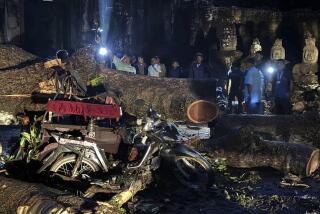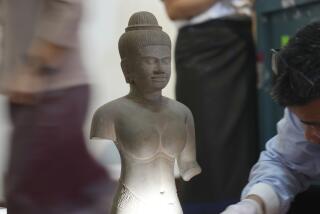U.N. Seeks to Save Fabled Khmer Temples : Cambodia: Time, war and revolution have ravaged the ancient cultural icons. Officials say full restoration could cost up to $100 million.
- Share via
ANGKOR WAT, Cambodia — The fabled temples of Angkor, some lost for centuries to the Cambodian jungle, need tens of millions of dollars to repair the ravages of time and two decades of war and revolution, UNESCO’s head said Saturday.
“This superb symbol of Khmer culture is a wonderful example of creativity and deserves to be a site for mankind as a whole,” Federico Mayor told reporters at Angkor Wat, the jewel of the vast Angkor complex in Cambodia’s northwestern Siem Reap province.
Mayor, head of the U.N. Educational, Scientific and Cultural Organization, was touring Angkor Wat the day after Cambodia’s new head of state, Prince Norodom Sihanouk, signed an accord bringing Angkor under international protection.
This was made possible by the signing of a formal end to Cambodia’s 13-year civil war last month in Paris.
“Normally when you have been told so many times how beautiful a site is, you see it and you are disappointed. In the case of Angkor it is exactly the opposite,” Mayor said.
He said initial urgent restoration work over the next year would require between $1.5 million and $2 million. In all, the work could take 20 years and cost up to $100 million, he said.
Mayor said he expects countries such as France and Japan to provide funds. He said he hopes there will be considerable interest from the private sector worldwide.
Behind him were the five central towers of Angkor Wat, Cambodia’s national symbol, the tallest of which rises 180 feet above the surrounding flatlands.
The temple, decorated throughout with intricate bas reliefs depicting marching armies and half-naked dancing girls--known as apsaras , or angels--dates to the 12th Century, when the Khmer empire was at its height.
The Angkor complex covers an area of 77 square miles. From here Khmer kings once ruled an empire stretching from Vietnam to southern China and the Bay of Bengal.
Angkor Wat remains in use as a Buddhist temple and has been spared some of the more extreme ravages of other parts of the complex.
The disused Ta Prohm temple, also from the 12th Century, has been taken over by fast-growing banyan trees, and creepers dozens of yards long enmesh its friezes.
“The trees are literally ripping the monument apart,” said Richard Engelhardt, UNESCO’s chief of mission in Phnom Penh and the archeologist responsible for the upkeep of Angkor.
In Angkor Wat, damage to the region’s ancient irrigation system over the centuries, and especially in the past 20 years of war, has drained the underlying water table, and the weight of the central towers has caused them to subside, leaving large cracks between giant carved stone blocks.
More to Read
Sign up for Essential California
The most important California stories and recommendations in your inbox every morning.
You may occasionally receive promotional content from the Los Angeles Times.










